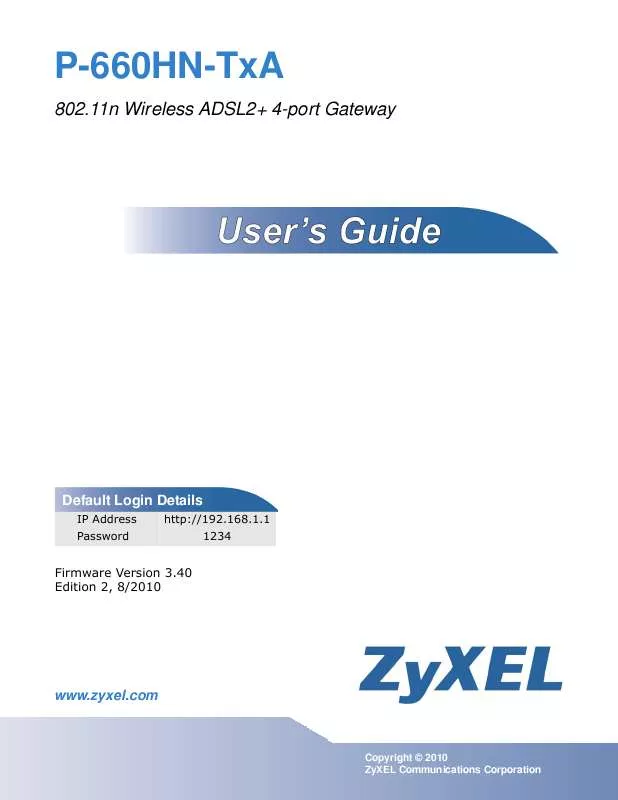User manual ZYXEL P-660HNT1
Lastmanuals offers a socially driven service of sharing, storing and searching manuals related to use of hardware and software : user guide, owner's manual, quick start guide, technical datasheets... DON'T FORGET : ALWAYS READ THE USER GUIDE BEFORE BUYING !!!
If this document matches the user guide, instructions manual or user manual, feature sets, schematics you are looking for, download it now. Lastmanuals provides you a fast and easy access to the user manual ZYXEL P-660HNT1. We hope that this ZYXEL P-660HNT1 user guide will be useful to you.
Lastmanuals help download the user guide ZYXEL P-660HNT1.
You may also download the following manuals related to this product:
Manual abstract: user guide ZYXEL P-660HNT1
Detailed instructions for use are in the User's Guide.
[. . . ] P-660HN-TxA
802. 11n Wireless ADSL2+ 4-port Gateway
Default Login Details
IP Address Password http://192. 168. 1. 1 1234
Firmware Version 3. 40 Edition 2, 8/2010
www. zyxel. com
www. zyxel. com
Copyright © 2010 ZyXEL Communications Corporation
About This User's Guide
About This User's Guide
Intended Audience
This manual is intended for people who want to configure the ZyXEL Device using the web configurator. You should have at least a basic knowledge of TCP/IP networking concepts and topology.
Related Documentation
· Quick Start Guide The Quick Start Guide is designed to help you get up and running right away. It contains information on setting up your network and configuring for Internet access. · Support Disc Refer to the included CD for support documents. [. . . ] It will be the registrar in all subsequent WPS connections in which it is involved. If you want a configured AP to act as an enrollee, you must reset it to its factory defaults.
P-660HN-TxA User's Guide
131
Chapter 8 Wireless LAN
8. 8. 8. 4 Example WPS Network Setup
This section shows how security settings are distributed in an example WPS setup. The following figure shows an example network. In step 1, both AP1 and Client 1 are unconfigured. When WPS is activated on both, they perform the handshake. In this example, AP1 is the registrar, and Client 1 is the enrollee. The registrar randomly generates the security information to set up the network, since it is unconfigured and has no existing information.
Figure 61 WPS: Example Network Step 1
ENROLLEE REGISTRAR
SECURITY INFO
CLIENT 1
AP1
In step 2, you add another wireless client to the network. You know that Client 1 supports registrar mode, but it is better to use AP1 for the WPS handshake with the new client since you must connect to the access point anyway in order to use the network. In this case, AP1 must be the registrar, since it is configured (it already has security information for the network). AP1 supplies the existing security information to Client 2.
Figure 62 WPS: Example Network Step 2
REGISTRAR EXISTING CONNECTION
CLIENT 1
AP1
ENROLLEE
O INF ITY R CU SE
CLIENT 2 In step 3, you add another access point (AP2) to your network. AP2 is out of range of AP1, so you cannot use AP1 for the WPS handshake with the new access
132
P-660HN-TxA User's Guide
Chapter 8 Wireless LAN point. However, you know that Client 2 supports the registrar function, so you use it to perform the WPS handshake instead.
Figure 63 WPS: Example Network Step 3
EXISTING CONNECTION
CLIENT 1
IS EX
ION CT NE N CO ING T
AP1
REGISTRAR
CLIENT 2
SE CU RIT Y
ENROLLEE
INF O
AP2
8. 8. 8. 5 Limitations of WPS
WPS has some limitations of which you should be aware. · WPS works in Infrastructure networks only (where an AP and a wireless client communicate). It does not work in Ad-Hoc networks (where there is no AP). · When you use WPS, it works between two devices only. You cannot enroll multiple devices simultaneously, you must enroll one after the other. For instance, if you have two enrollees and one registrar you must set up the first enrollee (by pressing the WPS button on the registrar and the first enrollee, for example), then check that it successfully enrolled, then set up the second device in the same way. · WPS works only with other WPS-enabled devices. However, you can still add non-WPS devices to a network you already set up using WPS. WPS works by automatically issuing a randomly-generated WPA-PSK or WPA2PSK pre-shared key from the registrar device to the enrollee devices. Whether the network uses WPA-PSK or WPA2-PSK depends on the device. You can check the configuration interface of the registrar device to discover the key the network is using (if the device supports this feature). [. . . ] If this device does cause harmful interference to radio/television reception, which can be determined by turning the device off and on, the user is encouraged to try to correct the interference by one or more of the following measures: 1 2 3 Reorient or relocate the receiving antenna. Increase the separation between the equipment and the receiver. Connect the equipment into an outlet on a circuit different from that to which the receiver is connected. Consult the dealer or an experienced radio/TV technician for help.
4
FCC Radiation Exposure Statement
· This transmitter must not be co-located or operating in conjunction with any other antenna or transmitter. [. . . ]
DISCLAIMER TO DOWNLOAD THE USER GUIDE ZYXEL P-660HNT1 Lastmanuals offers a socially driven service of sharing, storing and searching manuals related to use of hardware and software : user guide, owner's manual, quick start guide, technical datasheets...manual ZYXEL P-660HNT1


 ZYXEL P-660HNT1 FICHE TECHNIQUE (614 ko)
ZYXEL P-660HNT1 FICHE TECHNIQUE (614 ko)
 ZYXEL P-660HNT1 QUICK START GUIDE (238 ko)
ZYXEL P-660HNT1 QUICK START GUIDE (238 ko)
